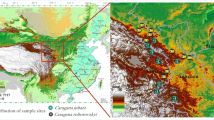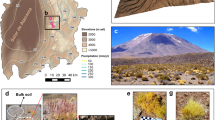Abstract
Management of soils to facilitate plant beneficial microbial interactions requires basic knowledge of the species composition and microbial community structures in the plant rhizosphere. Here, we examined composition of bacterial communities associated with rhizosphere microsites located at the root tips and mature root zones of Lolium perenne when grown in Chilean ash-derived volcanic soils (Andisols: Freire and Piedras Negras soil series). Community structures were analyzed by pyrosequencing of 16S ribosomal RNA (rRNA) genes followed by in silico analysis for phylogenetic assignments (MOTHUR and Visualization tool for Taxonomic Compositions of Microbial Community (VITCOMIC)). Analysis of the community structure revealed significant differences in community structures in relation to the soil series, which differed particularly in the relative abundance of Cyanobacteria and Firmicutes. However, no significant differences were observed with respect to root microsite location in the same Andisol series. Predominant taxa included members of the Proteobacteria, Actinobacteria, and Acidobacteria. Analysis by VITCOMIC showed that dominant bacterial groups comprised only 5 to 10 % of the total bacterial community and the remaining majority of bacteria included low-abundant taxa (Fusobacteria, Thermotogae, Lentisphaerae, Tenericutes, Deferribacteres Spirochaetes, Planctomycetes, Thermotogae, and Deinococcus-Thermus), most of which have not been previously reported or associated with the plant rhizosphere according to GenBank database. The results indicate that most of bacteria in the Chilean Andisols have not been described to the rhizosphere plants and their functional traits are still largely unknown.







Similar content being viewed by others
References
Arjun JK, Harikrishnan K (2011) Metagenomics analysis of bacterial diversity in the rice rhizosphere soil microbiome. Biotechnol Bioinf Bioeng 1:361–367
Barret M, Morrissey JP, O’Gara F (2011) Functional genomics analysis of plant growth-promoting rhizobacterial traits involved in rhizosphere competence. Biol Fertil Soils 47:729–743
Bastida F, Moreno JL, Nicolas C, Hernandez T, Garcia C (2009) Soil metaproteomics: a review of an emerging environmental science. Significance, methodology and perspectives. Eur J Soil Sci 60:845–859
Bertin C, Yang X, Weston LA (2003) The role of root exudates and allelochemicals in the rhizosphere. Plant Soil 256:67–83
Bertsch PM, Bloom PR (1996) Aluminum. In: Bigham JM (ed) Methods of soil analysis, part 3—chemical methods. Soil Science Society of America, Madison, pp 526–527
Chaer G, Fernandes M, Myrold D, Bottomley P (2009) Comparative resistance and resilience of soil microbial communities and enzyme activities in adjacent native forest and agricultural soils. Microb Ecol 58:414–424
Chaparro JM, Sheflin AM, Manter D, Vivanco JM (2012) Manipulating the soil microbiome to increase soil health and plant fertility. Biol Fertil Soils 48:489–499
de Campos SB, Youn JW, Farina R, Jaenicke S, Jünemann S, Szczepanowski R, Beneduzi A, Vargas LK, Goesmann A, Wendisch VF, Passaglia LMP (2013) Changes in root bacterial communities associated to two different development stages of canola (Brassica napus l. var. oleifera) evaluated through next-generation sequencing technology. Microb Ecol 65:593–601
DeAngelis KM, Brodie EL, DeSantis TZ, Andersen GL, Lindow SE, Firestone MK (2009) Selective progressive response of soil microbial community to wild oat roots. ISME J 3:168–178
Dini-Andreote F, Elsas JD (2013) Back to the basics: the need for ecophysiological insights to enhance our understanding of microbial behaviour in the rhizosphere. Plant Soil 373:1–15
Edgar RC, Haas BJ, Clemente JC, Quince C, Knight R (2011) UCHIME improves sensitivity and speed of chimera detection. Bioinformatics 27:2194–2200
Garveba P, van Veen JA, van Elsas JD (2004) Microbial diversity in soils: selection of microbial populations by plant and soil type and implication for disease suppressiveness. Annu Rev Phytopathol 42:243–270
Good IJ (1953) The population frequencies of species and the estimation of population parameters. Biometrika 40:237–264
Hannula SE, de Boer W, van Veen JA (2014) Do genetic modification in crops affect soil fungi? a review. Biol Fertil Soils 50:433–446
Hayat R, Ali S, Amara U, Khalid R, Ahmed I (2010) Soil beneficial bacteria and their role in plant growth promotion: a review. Annu Rev Microbiol 60:579–598
He J, Xu Z, Hughes J (2005) Pre-lysis washing improves DNA extraction from a forest soil. Soil Biol Biochem 37:2337–2341
Hinsinger P, Gobran GR, Gregory PJ, Wenzel WW (2005) Rhizosphere geometry and heterogeneity arising from root-mediated physical and chemical processes. New Phytol 168:293–303
Jaeger CH, Lindow SE, Miller W, Clark E, Firestone MK (1999) Mapping of sugar and amino acid availability in soil around roots with bacterial sensors of sucrose and tryptophan. Appl Environ Microbiol 65:2685–2690
Janssen PH (2006) Identifying the dominant soil bacterial taxa in libraries of 16S rRNA and 16S rRNA genes. Appl Environ Microbiol 72:1719–1728
Jorquera MA, Hernandez MT, Rengel Z, Marschner P, Mora ML (2008) Isolation of culturable phosphobacteria with both phytate-mineralization and phosphate-solubilization activity from the rhizosphere of plants grown in a volcanic soil. Biol Fertil Soils 44:1025–1034
Jorquera MA, Hernández M, Martínez O, Marschner P, Mora ML (2010) Detection of aluminium tolerance plasmids and microbial diversity in the rhizosphere of plants grown in acidic volcanic soil. Eur J Soil Biol 46:255–263
Jorquera MA, Crowley DE, Marschner P, Greiner R, Fernández MT, Romero D, Menezes-Blackburn D (2011) Identification of β-propeller phytase-encoding genes in culturable Paenibacillus and Bacillus spp. from the rhizosphere of pasture plants on volcanic soils. FEMS Microbiol Ecol 75:163–172
Lin YT, Jangid K, Whitman WB, Coleman DC, Chiu CY (2011) Change in bacterial community structure in response to disturbance of natural hardwood and secondary coniferous forest soils in central Taiwan. Microb Ecol 61:429–437
Lombard N, Prestat E, van Elsas JD, Simonet P (2011) Soil-specific limitations for access and analysis of soil microbial communities by metagenomics. FEMS Microbiol Ecol 78:31–49
Marschner P, Crowley DE, Lieberei R (2001a) Arbuscular mycorrhizal infection changes the bacterial 16 S rDNA community composition in the rhizosphere of maize. Mycorrhiza 11:297–302
Marschner P, Yang C, Lieberei R, Crowley DE (2001b) Soil and plant specific effects on bacterial community composition in the rhizosphere. Soil Biol Biochem 33:1437–1445
Marschner P, Crowley DE, Hong Yang C (2004) Development of specific rhizosphere bacterial communities in relation to plant species, nutrition and soil type. Plant Soil 261:199–208
Marschner P, Crowley DE, Rengel Z (2011) Rhizosphere interactions between microorganisms and plants govern iron and phosphorus acquisition along the root axis—model and research methods. Soil Biol Biochem 43:883–894
Martínez O, Jorquera MA, Crowley DE, Mora ML (2011) Influence of nitrogen fertilisation on pasture culturable rhizobacteria occurrence and the role of environmental factors on their potential PGPR activities. Biol Fertil Soils 47:875–885
Mora ML, Baeza G, Pizarro C, Demanet R (1999) Effect of calcitic and dolomitic lime on physicochemical properties of a chilean Andisol. Commun Soil Sci Plant Anal 30:427–439
Mori H, Maruyama F, Kurokawa K (2010) VITCOMIC: visualization tool for taxonomic compositions of microbial communities based on 16S rRNA gene sequences. BMC Bioinforma 11:332–341
Murphy J, Riley JP (1962) A modified single solution method for the determination of phosphate in natural waters. Anal Chim Acta 27:31–36
Nannipieri P, Ascher J, Ceccherini MT, Guerri G, Renella G, Pietramellara G (2008a) Recent advances in functional genomics and proteomics of plant associated microbes. In: Nautiyal CS, Dion P (eds) Molecular mechanisms of plant and microbe coexistence. Springer, Heideleberg, pp 215–241
Nannipieri P, Ascher J, Ceccherini MT, Landi L, Pietramellara G, Renella G, Valori F (2008b) Effects of root exudates on microbial diversity and activity in rhizosphere soils. In: Nautiyal CS, Dion P (eds) Molecular mechanisms of plant and microbe coexistence. Springer, Heideleberg, pp 339–365
Pruesse E, Peplies J, Glöckner FO (2012) SINA: accurate high-throughput multiple sequence alignment of ribosomal RNA genes. Bioinformatics 28:1823–1824
Schloss PD, Westcott SL, Ryabin T (2009) Introducing MOTHUR: open-source, platform-independent, community-supported software for describing and comparing microbial communities. Appl Environ Microbiol 75:7537–7541
Suzuki C, Nagaoka K, Shimada A, Takenaka M (2009) Bacterial communities are more dependent on soil type than fertilizer type, but the reverse is true for fungal communities. Soil Sci Plant Nutr 55:80–90
Větrovský T, Baldrian P (2013) The variability of the 16S rRNA gene in bacterial genomes and its consequences for bacterial community analyses. Plos One 8:1–10
Wang ZY, Kelly JM, Kovar JL (2004) In situ dynamics of phosphorus in the solution of five species. J Environ Qual 33:1387–1392
Warncke D, Brown JR (1998) Potassium and other basic cations. In: Brown JR (ed) Recommended chemical soil test procedures for the North Central Region. NCR Publication No. 221. Missouri Agricultural Experiment Station, Columbia, pp 31–33
Watt M, Silk WK, Passioura JB (2006) Rates of root and organism growth, soil conditions, and temporal and spatial development of the rhizosphere. Ann Botan 97:839–855
Yang CH, Crowley DE (2000) Rhizosphere microbial community structure in relation to root location and plant iron nutritional status. Appl Environ Microbiol 66:345–351
Yang C, Hamel C, Gan Y, Vujanovic V (2012) Pyrosequencing reveals how pulses influence rhizobacterial communities with feedback on wheat growth in the semiarid Prairie. Plant Soil 367:493–505
Acknowledgments
This study was supported by FONDECYT Project no.1120505 and 1141247. This research was partially supported by the supercomputing infrastructure of the NLHPC (ECM-02) (Responsible Dr. Andres Avila) at Centro de Modelación y Computación Científica at Universidad de La Frontera (CMCC-UFRO). L. Lagos thanks the CONICYT PhD Scholarships no. 21120698.
Author information
Authors and Affiliations
Corresponding author
Rights and permissions
About this article
Cite this article
Lagos, L.M., Navarrete, O.U., Maruyama, F. et al. Bacterial community structures in rhizosphere microsites of ryegrass (Lolium perenne var. Nui) as revealed by pyrosequencing. Biol Fertil Soils 50, 1253–1266 (2014). https://doi.org/10.1007/s00374-014-0939-2
Received:
Revised:
Accepted:
Published:
Issue Date:
DOI: https://doi.org/10.1007/s00374-014-0939-2




